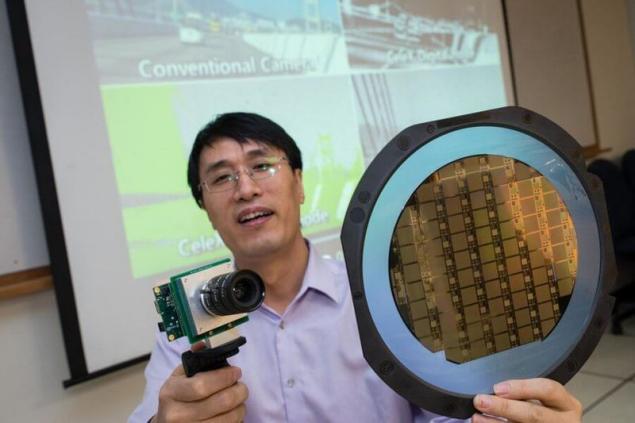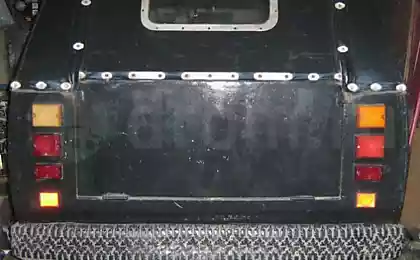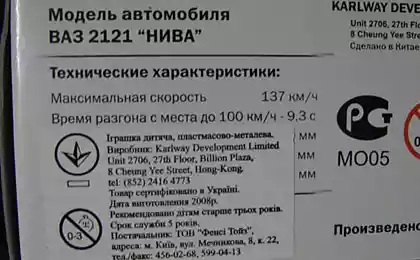506
New camera improves vision and reaction speed self-propelled vehicles
Scientists from Singapore's Nanyang technological University (NTU) have developed ultra-fast camera with high contrast, which can help self-propelled vehicles and drones to better ' see ' in extreme road conditions and bad weather. Unlike conventional optical cameras, which "dazzle" bright light and in the dark they are unable to discern the details, the new smart camera can record even slight subject movement in real-time.

Assistant Professor at Nanyang technological University (Singapore) Chen Shoushan (Chen Shoushun) have developed ultra-fast camera with unique built-in IC chip enabling instant analysis of cut scenes, emphasizing the important objects and details
The advantages of the new design in comparison with existing technologies
The new camera records changes in the intensity of the lighting between scenes with an interval measured in nanoseconds. It is much faster than conventional video. The camera also saves images in the format of the data, allowing them to be much smaller than usual.
With its unique built-in IC chip, the camera can make instant analysis of shooting her scenes, emphasizing the important objects and details.
The camera is designed assistant Professor Jong Shoshana (Chen Shoushun) from School of electrical and electronic engineering, Nanyang technological University. It was called Celex, and its development has now entered its final phase.
According to its developer:
"Our new camera can be a great security tool for the self-propelled transport, because she can see much better optical cameras, but without the time lag necessary for the analysis and processing of the video stream".
Developed by scientists allows the camera to continuously monitor and quickly analyze the scene. Its mission is to help self-propelled transport, and drones to avoid unexpected collisions that typically occur in a matter of seconds.

Camera Celex was shown in January of this year, held in the United States, the Symposium IS&T International Symposium on Electronic Imaging (EI 2017). She received positive feedback from those present at the Symposium, many of whom are scientists and leading industry representatives.
How does the new camera?
The sensor of a conventional camera has millions of pixels, allowing you to record information about the lighting that is used to form the final image.
Characterized by high speed video camera capable of recording up to 120 pictures per second, thus generating gigabytes of video data that are processed by the computer to allow self-propelled transportation "see" and analyze their environment.
What environment is more difficult, the slower the processing of video data. The result is a lag between what the camera something to "see," and the action to be carried out self-propelled vehicle in response to what he saw.
In order to implement snapshot processing the visual data of the new camera Nanyang technological University writes changes between the intensity of illumination of the individual pixels of your sensor that reduces the output data. This allows you to avoid having to get the whole scene like a photographer and increases the processing speed of the camera.
The camera sensor also has a built-in processor that can instantly analyze the data flow, determining the differences between foreground objects and background. This process is also called the computation of the optical flow. The innovation can give the self-propelled vehicle more time to react to approaching vehicles or obstacles.
As reported, the study of the sensor technology started in 2009 and has received 500 thousand dollars grants. This technology was also published in two academic journals of the Institute of electrical and electronics engineers (IEEE), which is the world's largest professional organization dedicated to issues of technological progress.
Prospects of application of technology
The industry has shown to this technology of interest. Professor Chen Shoushan with his colleagues formed a startup company Hillhouse Tech, which aims to commercialize the production technology of the considered cameras. This is a startup incubator NTUitive, company, Nanyang technological University, innovate. Professor Chen Shoushan expects that the new camera will be ready for commercial use until the end of the year. Negotiations with global electronics manufacturers. published
P. S. And remember, only by changing their consumption — together we change the world! ©
Source: hi-news.ru/digital-cameras/novaya-kamera-uluchshaet-zrenie-i-skorost-reakcii-samoxodnyx-avtomobilej.html

Assistant Professor at Nanyang technological University (Singapore) Chen Shoushan (Chen Shoushun) have developed ultra-fast camera with unique built-in IC chip enabling instant analysis of cut scenes, emphasizing the important objects and details
The advantages of the new design in comparison with existing technologies
The new camera records changes in the intensity of the lighting between scenes with an interval measured in nanoseconds. It is much faster than conventional video. The camera also saves images in the format of the data, allowing them to be much smaller than usual.
With its unique built-in IC chip, the camera can make instant analysis of shooting her scenes, emphasizing the important objects and details.
The camera is designed assistant Professor Jong Shoshana (Chen Shoushun) from School of electrical and electronic engineering, Nanyang technological University. It was called Celex, and its development has now entered its final phase.
According to its developer:
"Our new camera can be a great security tool for the self-propelled transport, because she can see much better optical cameras, but without the time lag necessary for the analysis and processing of the video stream".
Developed by scientists allows the camera to continuously monitor and quickly analyze the scene. Its mission is to help self-propelled transport, and drones to avoid unexpected collisions that typically occur in a matter of seconds.

Camera Celex was shown in January of this year, held in the United States, the Symposium IS&T International Symposium on Electronic Imaging (EI 2017). She received positive feedback from those present at the Symposium, many of whom are scientists and leading industry representatives.
How does the new camera?
The sensor of a conventional camera has millions of pixels, allowing you to record information about the lighting that is used to form the final image.
Characterized by high speed video camera capable of recording up to 120 pictures per second, thus generating gigabytes of video data that are processed by the computer to allow self-propelled transportation "see" and analyze their environment.
What environment is more difficult, the slower the processing of video data. The result is a lag between what the camera something to "see," and the action to be carried out self-propelled vehicle in response to what he saw.
In order to implement snapshot processing the visual data of the new camera Nanyang technological University writes changes between the intensity of illumination of the individual pixels of your sensor that reduces the output data. This allows you to avoid having to get the whole scene like a photographer and increases the processing speed of the camera.
The camera sensor also has a built-in processor that can instantly analyze the data flow, determining the differences between foreground objects and background. This process is also called the computation of the optical flow. The innovation can give the self-propelled vehicle more time to react to approaching vehicles or obstacles.
As reported, the study of the sensor technology started in 2009 and has received 500 thousand dollars grants. This technology was also published in two academic journals of the Institute of electrical and electronics engineers (IEEE), which is the world's largest professional organization dedicated to issues of technological progress.
Prospects of application of technology
The industry has shown to this technology of interest. Professor Chen Shoushan with his colleagues formed a startup company Hillhouse Tech, which aims to commercialize the production technology of the considered cameras. This is a startup incubator NTUitive, company, Nanyang technological University, innovate. Professor Chen Shoushan expects that the new camera will be ready for commercial use until the end of the year. Negotiations with global electronics manufacturers. published
P. S. And remember, only by changing their consumption — together we change the world! ©
Source: hi-news.ru/digital-cameras/novaya-kamera-uluchshaet-zrenie-i-skorost-reakcii-samoxodnyx-avtomobilej.html
India expects to start mining helium-3 on the moon by 2030
9 things that the language is trying to tell us about our health























